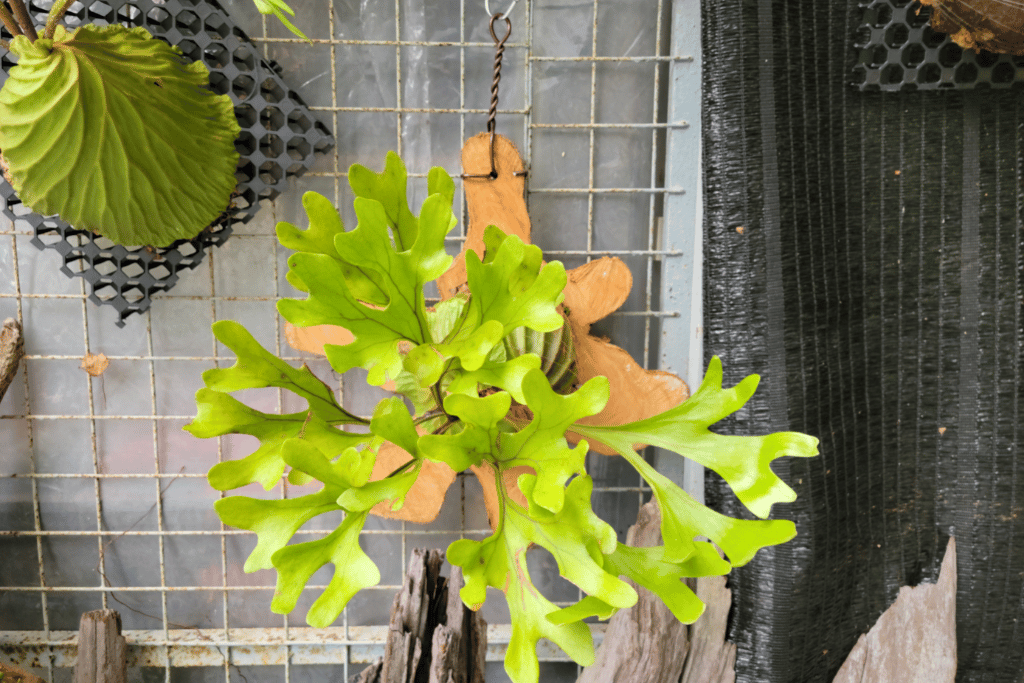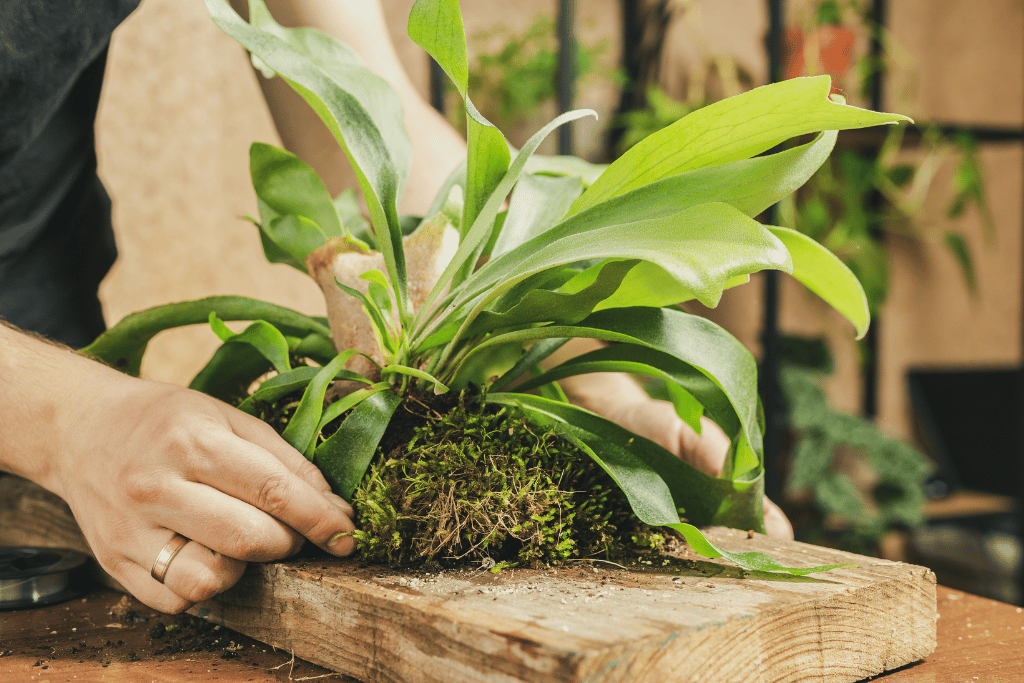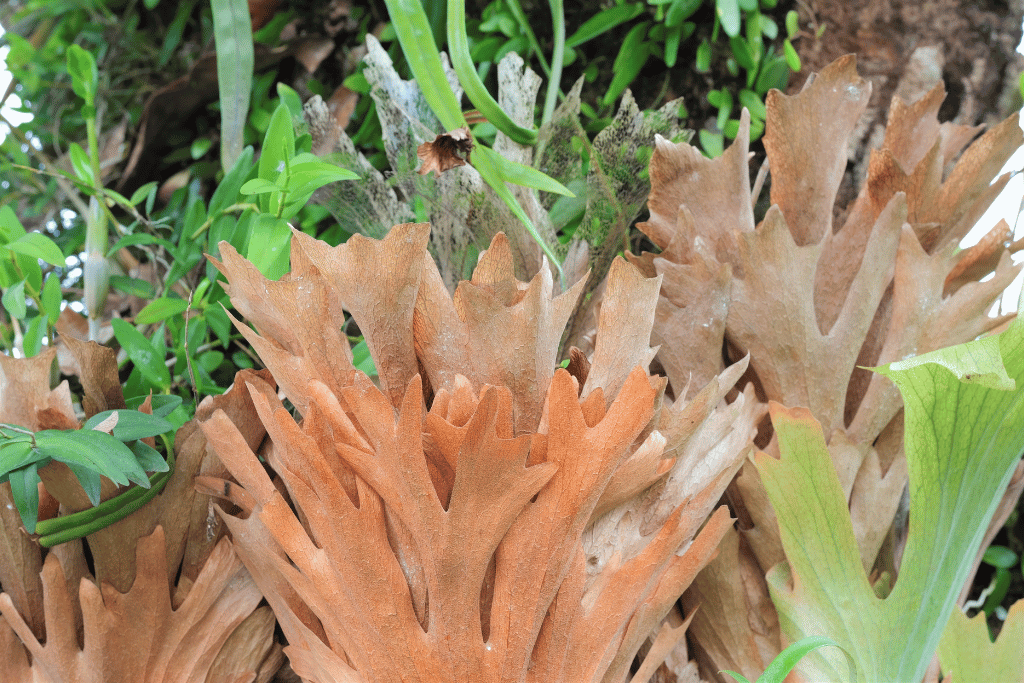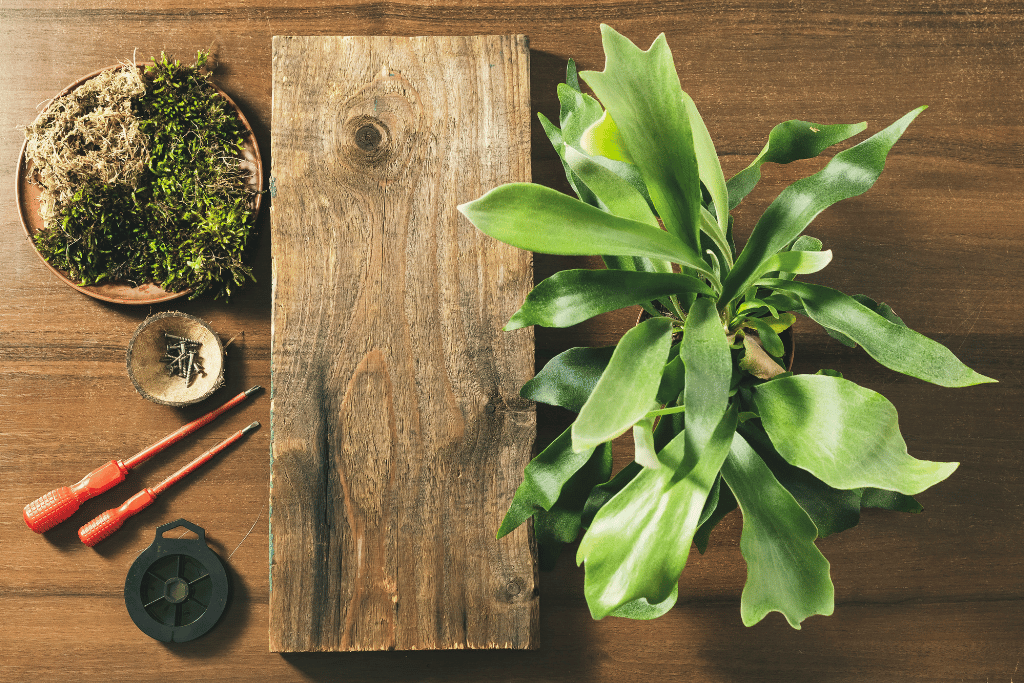
If you’re a plant enthusiast, chances are you’ve come across a staghorn fern at some point in your botanical adventures. These unique greens can be a bit finicky when it comes to care, but with love and attention, it’s not too difficult to bring them back from the brink of death. So read on, as I’m about to impart some wisdom on how to save a dying staghorn fern and provide it with its former glory!
About The Staghorn Fern

The staghorn fern (Platycerium bifurcation) is a fascinating exotic gem that stands out from the crowd. It belongs to the Polypodiaceae family, which includes ferns that grow on rocks, trees, and even on the ground. What sets this special greenery apart from its relatives is a one-of-a-kind growth habit – as an epiphytic, it grows on other plants and trees without causing any harm to them.
These clever hitchhikers have a striking appearance, with two different types of fronds. The first type is the fertile frond, which is large and flat, resembling the antlers of a stag, hence the common name. The second kind is the sterile frond, which is smaller and rounder, forming a rosette around the base of the plant. Both varieties of fronds work together to create a stunning and unusual appearance that makes the staghorn fern a favorite among green thumbs.
In terms of size, staghorn ferns vary depending on age and growing conditions. Usually, they grow up to 3 feet (about 1 meter) tall and 4 feet (about 1.2 meters) wide.
This versatile green feels at home indoors and outdoors as well, and qualifies as a shade-tolerant hanging plant too. However, keep in mind that its epiphytic nature poses a challenge to cultivation in soil. Instead, grow it on a mount, such as a piece of wood or a wire basket, where it is free to attach its roots and stretch vertically.
Quick Staghorn Fern Care Overview

- Soil: Your best shot at mimicking the plant’s soilless environment is to use a potting mix made of a combination of substrates like orchid bark, sphagnum moss, and perlite.
- Watering: No overwatering and no underwatering – finding the perfect middle ground for hydration is key. Aim to give your staghorn fern a drink once the soil feels dry to the touch.
- Light: Staghorn ferns prefer bright, indirect light. Too much direct sunlight eventually causes sunburn and irreversible damage to the foliage.
- Humidity: Just like in their homeland, these magnificent greens thrive in high humidity. But living in a dry place doesn’t have to rule out keeping a staghorn fern. Just pay attention to increasing the water content of the air regularly.
- Temperature: The ideal temperature for staghorn ferns is between 60 and 80 Fahrenheit (15-26 Celsius). Avoid placing them in drafty areas or near heating or cooling vents to prevent shock.
- Fertilization: Although this lush green benefits from some occasional fertilization, it will also thrive without manually adding nutrients to its potting mix.
Signs of a Dying Staghorn Fern

What does a dying staghorn fern look like? Well, there are several warnings to watch out for, and the earlier you catch them the better chance you have at reviving your leafy companion.
One common symptom is wilting or yellowing fronds, which can be caused by overwatering, underwatering, or poor drainage. Another problem might be the emergence of brown or black patches on the fronds, which are usually brought about by fungal or bacterial infections, sunburn, or even pest infestation. Additionally, if you find the root ball of the greenery dry, shriveled, or smelly, you may be dealing with root rot.
Halted growth, and weak or spindly leaves that are droopy and shedding are other common staghorn fern problems. Moreover, if the soil is too dry or poorly drained, the fronds are at a higher risk to develop brown, crispy edges, which is a sign of dehydration. Similarly, in case the soil is too waterlogged, the roots will likely rot, leading to collapsing fronds. If the mix is lacking in nutrients, the plant might become pale and yellowish, which hints at nutrient deficiency.
To bring a struggling staghorn fern back to life, it is essential to identify the underlying cause of its symptoms and take appropriate action, such as adjusting watering or light levels, treating for pests or diseases, or repotting in fresh soil with excellent drainage and aeration.
What Causes Staghorn Fern Leaves to Turn Brown?

An extremely common question, and an even fairer one. In case you are just getting familiar with the maintenance of staghorn ferns, you will eventually notice some of its fronds turning brown. I’m not talking about discolored spots or crispy edges; those are clearly health issues. What I mean is the whole of the fronds changing to brown color. Don’t freak out at that sight, and keep your cool, as this is exactly what’s supposed to happen!
The phenomenon is a natural part of the plant’s lifecycle and not a sign of impending doom.
In fact, brown fronds on staghorn ferns simply indicate that the fronds have reached the end of their useful life. As the leaves age, browning will take place, and the spent ones will die, making way for new growth.
If you want to keep your greenery healthy, it’s crucial to understand its lifecycle and treat it right. And remember: While it may be tempting to remove the brown leaves, it’s actually best to leave them intact, since they provide important nutrients to the plant while breaking down, supporting continuous development.
How to Save A Dying Staghorn Fern

If the damage is already done, there’s no turning back: you have to work with what you got and get the most out of the situation. Fortunately, a sad-looking plant doesn’t automatically mean it should land in the trash. I’d recommend you learn your lesson and take on the challenge to mitigate casualties. Grab my top tips quickly, and put them into practice to rejuvenate your depressed little fellow:
- Light: Staghorn ferns require bright, indirect light to thrive. If sun exposure is inadequate, choose a different spot with bright, filtered light. A north-facing or east-facing window, or a wall that receives soft light is ideal. In case you grow your green indoors, make sure to rotate it every few weeks to ensure it evenly receives the nurturing sunrays.
- Water: Staghorn ferns prefer moist but well-draining soil. Keeping it in a pot only works with drainage holes at the bottom to boost air circulation and give excess water a way to escape. Does the soil stay wet for longer than you expected? Consider adding perlite or sand to the mix. It ultimately boils down to the climate, but generally, once a week during summer and once every other week in winter should be sufficient watering. Additionally, you can also mist the fronds to increase humidity, especially during the hot summer months.
- Humidity: Staghorn ferns love humid surroundings. Increase humidity by misting the fronds regularly or placing the plant on a tray filled with pebbles and water. Alternatively, use a humidifier or group plants together to create a microclimate. In addition, you can wrap sphagnum moss around the root ball to help retain moisture.
- Fertilization: You cannot go wrong with a monthly dose of diluted liquid fertilizer during the growing season, but you can skip this step altogether if you want. Fertilization should only happen during spring and summer and be stopped during fall and winter.
- Pruning: If your staghorn fern is severely damaged, prune away any dead or dying fronds using clean, sharp shears. Repot the plant if necessary. Avoid injuring any healthy parts and keep the growing medium damp until new growth appears. Regularly remove any spent fronds to encourage constant development. Furthermore, if your plant is mounted on the wall, try reattaching it to a new board or surface with fresh sphagnum moss to provide nutrients and support longevity.
- Positioning: If you live in a place that experiences high levels of humidity, such as California, Georgia, or South Carolina, it’s best advised that you keep your exotic beauty in a shady location outdoors during the summer months or all year round. However, as the temperature begins to drop and falls below 60 Fahrenheit (15 Celsius), it’s best to bring it back indoors to avoid staghorn fern freeze damage.
Final Words
I hope this guide has given you all the knowledge you need to understand how to save a dying staghorn fern. Remember, every plant is unique and may require slightly different care, so don’t be afraid to experiment and find what works best for your leafy companion.
Frequently Asked Questions (FAQ)
Will staghorn fern grow back?
Yes, the staghorn fern will produce new growth once you shift to proper care with the right amount of sunlight, watering, nutrients, and quality mix.
What is the best natural fertilizer for staghorn ferns?
DIY fertilizers are an excellent way to provide staghorn ferns with some additional nutrition. Compost, worm castings, or diluted fish emulsion work just fine. However, coffee grounds and banana peels are great alternatives too, but should only be used sparingly and mixed well into the potting mix to avoid overfeeding or attracting pests.
Should I remove brown leaves from my staghorn fern?
It’s recommended to leave the brown or tan basal fronds of the staghorn fern intact, even if they appear lifeless, as they serve the important function of anchoring and safeguarding the plant until they eventually drop off on their own.



